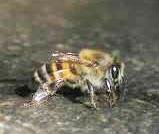Home > Hiking hints > Health & safety > Bee stings
'Bee' prepared ...
Bee stings
Often in the middle of summer, JHC members encounter bees when out in the mountains and kloofs. For those individuals with no allergies this is not a serious problem. However it can be a life threatening situation for some.
One should understand a bit about bee behaviour so that a bee attack can be dealt with more easily. Bees are not normally aggressive and only attack in defence of their hive. Bees do not have time to get aggressive when, in an apiary, the honey is removed and thus keeping the bees busy by refilling combs and maintaining the hive. The beekeeper works with a smoker in order to keep the bees passive.
In the wild, after a good rainy season, there are plenty of flowers and nectar and the hive is probably bursting at the seams with honey so the bees have nothing to do except get bad tempered. One thing that easily makes bees aggressive is a very hot day and a passerby with a sweaty body ?– hikers.
SMOKE is the most important tool when a beekeeper works on his hives. The whiff of smoke to a bee means one thing - FIRE and a possible threat to the queen, hive and honey. The bees' immediate response is to go to the combs and draw into their stomachs as much honey as they can carry. In this way if their hive is destroyed the swarm will have a bit of food to tide it over the period when they have to find and build another hive. These bees, which are full of honey, are concerned about the swarm and are not aggressive, hence the use of smoke by beekeepers.
If attacked by bees, try to separate and put some distance between you and the bees. Get some leaves or grass and make a small smoky fire as soon as possible. Stand in the smoke to get rid of the bees. Smoke neutralises the pheromone exuded by angry bees which causes the whole swarm to get angry and attack. It is not a good idea to get into a river as you will be nailed by the swarm each time you come up for air.
Bee sting prevention and treatment
Most people only experience the momentary pain and inflammation of a localized bee sting reaction. BUT a few hypersensitive individuals risk death from a single sting. ?‘Bee?’ prepared on your next outdoor trip. Make sure that you know how to deal with the symptoms of the more severe anaphylaxis (swelling of the air ways).
The best protection against a reaction to hymenoptera (bees and wasps) venom is to avoid being stung but this is often easier said than done.
Do not mimic a flower by wearing colourful clothes and fragrant perfumes. While dull clothes are the best, one should especially avoid the blues, greens and yellow that tend to attract bees. Do not wear flashy jewellery. To further lesson the risk of being stung, should bees suddenly appear, stay quiet rather than swatting or running away from them.
As a precautionary measure against some symptoms of anaphylaxis and some of the inflammation produced from normal and extensive allergic local reactions, take two aspirin tables and an antihistamine tablet about an hour before frequenting an area where there are likely to bees (if you know this!). This is especially if you are prone to allergic reactions of any kind.
Because death to analyphyactic shock may occur within 15 minutes or less, immediate medical action is essential for a bee sting victim who exhibits flushing, hives, itching, tight chest, difficulty in breathing, headache, dizziness, confusion, nausea, vomiting, and rapid heartbeat.
Treatment for normal and extensive local reactions includes:
- Gently scraping out the sting to avoid squeezing more venom into the tissue.
- Washing and applying an antiseptic to the sting site to prevent secondary infection
- Try and keep the patient calm
- Applying ice to slow venom absorption
- Administering moistened baking soda to relieve mild pain.
People, who know they are allergic to bee stings, should carry their own insect sting emergency medication/antihistamines kit with them.


